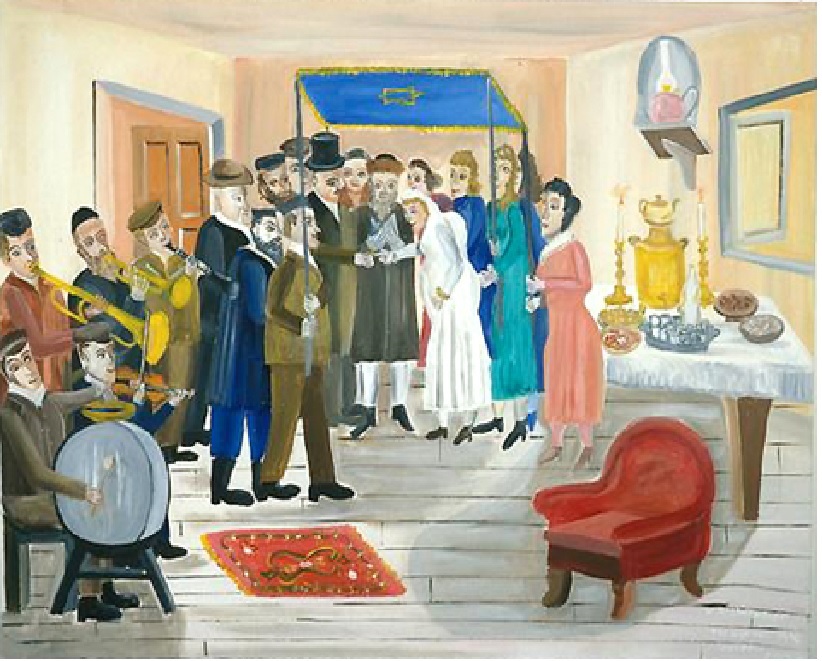VILKAVISKIS
A small town in Southern Lithuania
Where the Jewish Community is no more
Jewish life in Vilkaviskis under the Russian Rule
This material has been collected from personel memories and archival material
The Household

At the entrance to an average home in Vilkaviskis stood barrel filled with drinking water with a copper dipper on top, as well as a cabinet that stores food nearby. The cabinet contained preserves with a warning: ― You should not get into it. Next, situated in the kitchen was a chimney and a brick or earthen stove. In winters and nights, below the brick fireplace which was used as an oven sat a chicken coop with eggs. A container for pots and pans was accessible. Located nearby were a folding bed usually painted red. When the lid lifted, the bench interior became a bed with the straw tick mattress and pillow in the drawer below. There was also a table, a kerosene lamp, and a shelf for pots and pans. Next to the kitchen came the living room. Its walls were decorated with pictures and photographs of the family. The furniture consisted of a wall clock with weights hanging down and a chain to wind it up, a sofa which served both as a bed and hope chest, tables, chairs, wooden clothes closet and a tile oven.

MANAGING THE HOUSEHOLD Even on ordinary days, managing a household in old Vilkaviskis was a chore. A woman‘s job was never done. Besides her household duties, she cared for a large family. A grandmother, Dvore Trivasch, bore and raised five girls and five boys. Most families‘ incomes were slim, and these women who managed large households found ways to economize on food and clothing by reusing goods so that nothing was wasted. The Yiddish-speaking women mingled among their non-Jewish neighbors as they shopped in the market, and thereby, learned to speak bits of Lithuanian and Russian. Middle-class households with young children employed servants, often several at once. The higher the class, the more servants the family had. Most Jewish families had at least one ―maid of-all-work, a non-Jewish peasant girl from a nearby village who lived in the house, did the heavy cleaning, and tended the fires. Typically, she lit the fire on the Sabbath so the Jews could abide by the scripture and avoid work on this Holy Day.
HEATING THE HOUSE
Harsh winters brought the challenge of searching for wood, turf, and old grass to kindle fires and provide warmth. Fuels were burned in brick or tile ovens for heat. Some people experienced headaches from the carbon monoxide fumes of burning turf. Chimneys required cleaning. Accumulated soot in chimneys often caused fires, and many homes burned down. The koymen kerer [chimney cleaner] walked through town with ladders, brooms, brushes, and a long rope to which a weight was tied for pushing out the soot. The chimney cleaner‘s face was usually black from charcoal, and descriptions of his appearance were often associated with an aura of mystery.
LAUNDERING Washing clothes, a time-consuming and difficult task, was done only periodically. Preparation for washing clothes began by catching rainwater into large barrels placed beneath the edge of the shingled roof. Loyg [lye, a mixture of rainwater and wood ashes] created alkaline water for washing. During washdays the home took on a new look. The koymen [fireplace] was completely cleaned out, the chicken coop beneath moved, and a tripod was placed inside the fireplace. Planks of wood were laid near the open brick oven, and large wooden washtubs with plenty of long bars of soap were positioned on the planks. A large copper kesl [kettle] was placed in the fireplace over a tripod. Washerwomen came to the family home. All night professional washerwomen scrubbed and washed. From time to time, they fortified themselves with liberal portions of rozheve [dark bread], herring, and tea. The washing process was simple—they placed the laundry in a copper kettle, where the water was kept boiling, and in the morning the washerwomen took the clothes to the river or the Creek where they rinsed and beat the washed laundry with a prinik (Russian) [wooden grooved trowel]. After completing the rinsing, the washerwomen brought clothes home and hung them to dry, usually in the attic. Other laundry, when partly dry, was carted to the mangler, a person who had a contraption for drying and ironing water-laden cloth that consisted of a large wooden box on rollers and filled with rocks to weigh it down. To keep the linens smooth, they were wrapped around the wooden roller and placed under the mangle, which rolled back and forth by means of a pulley and a large wheel that squeezed out the water. When the clean laundry reached home, mothers mended the clothes and put them away ready for a weekly change
This site was built by Ralph Salinger of Kfar Ruppin, Israel
It is built to the glory of the Jewish Community of Vilkaviskis
You can contact me with any comments at salinger@kfar-ruppin.org,il
HOUSE CONSTRUCTION Building an ordinary one-story house took three or more years to complete. First the builder and his helpers went to the forest where they cut down the necessary trees. After measuring and re-measuring, they carefully sawed, chopped, hewed, and planked the trees until they formed the needed logs, boards and siding. This took about three to four months. Then they brought the lumber to town and laid it out on the market place field and the joists and planks were fitted taking another three to four months. Next came the foundation, and sometimes it was necessary to dig a cellar. Another three or four months were needed for framing the building. The siding, brick laying, and plastering consumed yet another three or four months. The roof, floors and final touches took additional time.





